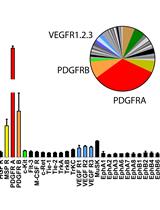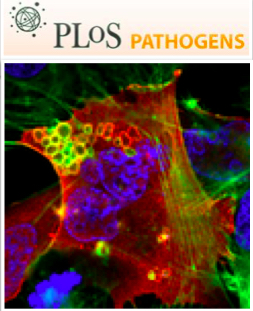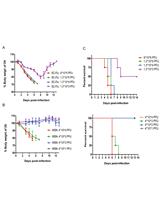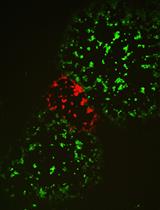- EN - English
- CN - 中文
Respiratory Syncytial Virus Infection in Mice and Detection of Viral Genomes in the Lung Using RT-qPCR
小鼠呼吸道合胞体病毒感染和采用RT-qPCT检测肺部的病毒基因组
发布: 2016年05月20日第6卷第10期 DOI: 10.21769/BioProtoc.1819 浏览次数: 11173
评审: Yannick DebingChang Ho LeeDavid Paul

相关实验方案

利用小鼠Phospho-RTK Array试剂盒无偏筛选肿瘤提取物中激活受体酪氨酸激酶
Julian Naipauer [...] Enrique A. Mesri
2019年04月20日 5628 阅读
Abstract
Respiratory syncytial virus (RSV) is a single-stranded negative sense RNA virus that belongs to the paramyxovirus family. RSV infections lead to a variety of clinical outcomes ranging from a mild “cold-like disease” to death. Infection is usually more severe in infants and the elderly. RSV is associated with the development and exacerbation of chronic lung conditions including asthma, and it is a major cause of hospitalizations in infants. Because of its clinical relevance, experimental animal models to study RSV in vivo are needed. The most common and accessible animal model in research laboratories is the mouse. However, commonly use RSV strains poorly establish infection in mice and thus titration of the virus from mouse lungs to confirm infection is not sensitive enough to detect early viral infection. Here we discuss in detail how to infect BALB/c mice with RSV and how to detect RSV genomes in the lung using reverse transcription quantitative PCR (RT-qPCR). This method allows detection of viral genomes as early as day 1 post-infection (shown in Figure 2), whereas traditional TCID50 fails to detect significant virus until after day 2 post-infection. Of note, despite of higher sensitivity, genome RT-qPCR only shows the production of viral genomes and thus positive results for this assay are not proof of production of infectious viral particles.
Keywords: Respiratory syncytial virus (呼吸道合胞病毒)Materials and Reagents
- Vacuum-driven Sterilcup® 500 ml Millipore ExpressPLUS 0.22 μm PES (Merck Millipore Corporation, catalog number: SCGPU05RE )
- FastPrep® tubes (MP Biomedicals, catalog number: 5076-400 )
- ¼” ceramic sphere (MP Biomedicals LLC, catalog number: 116540412 )
- CryoTubesTM vials for freezing viruses (Thermo Fisher Scientific, catalog number: 377267 )
- Surgical scissors (Roboz Surgical Instrument Co)
- Tweezers (Roboz Surgical Instrument Co)
- 384-well PCR plate (VWR International, catalog number: 82051-470 )
- PCR strip tubes, 0.2 ml (Bioexpress, catalog number: T-3035-2 )
- 0.22 μm filter used in the pipette aid (VWR International, catalog number: 28145-481)
- BSL2 personal protective equipment (PPE)
- Mice (Balb/c, 6-8 weeks old, gender-mixed) (Taconic)
- Human RSV strain A2 (ATCC, catalog number: VR-1540 )
- SYBR green master mix (Applied Biosystems, catalog number: 4368708 )
- qPCR primer sets
Genes Forward primer Reverse primer RSV g 5’AACATACCTGCCCAGAATC3’ 5’GGTCTTGACTGTTGTAGATTGCA3’ Rsp11 5’CGTGACGAAGATGAAGATGC3’ 5’ GCACATTGAATCGCACAGTC3’ α-tubulin 5’ TGCCTTTGTGCACTGGTATG3’ 5’ CTGGAGCAGTTTGACGACAC3’ - RSV genome RT primer: 5’GATAAATATAGGCATGGGGAAAGTG3’
- TRIzol reagent (Thermo Fisher Scientific, AmbionTM, catalog number: 15596018 )
- Chloroform (Sigma-Aldrich, catalog number: C2432-25 ml )
- Isopropanol (Sigma-Aldrich, catalog number: 437522 )
Note: It is also named “2-propanol” on Sigma-Aldrich website. - Ultra-Pure nuclease-free water
- SuperScript® III First-Strand Synthesis System (Thermo Fisher Scientific, InvitrogenTM, catalog number: 18080-051 )
- High capacity RNA-to-cDNATM kit (Thermo Fisher Scientific, Applied BiosystemsTM, catalog number: 4387406 )
- Ketamine (Henry Schein)
- Xylazine (U.S. Food and Drug Administration, AnaSed, catalog number: 139-236 )
- Phosphate buffered saline (PBS) (Thermo Fisher Scientific, GibcoTM, catalog number: 10010-023 )
- Ketamine/Xylazine solution (see Recipes)
- Primer preparation (see Recipes)
Equipment
- Biosafety hood in biosafety level 2 facility
- Applied Biosystem ViiATM 7 LightCycler (Life Technologies, catalog number: 4453536 )
Note: Currently, it is “Thermo Fisher Scientific, catalog number: 4453536”. - Eppendorf centrifuge 5415R (Eppendorf AG, catalog number: 22636570 )
Note: This product has been discontinued by Eppendorf AG. - NanoDrop 1000 spectrophotometer (Thermo Fisher Scientific, catalog number: ND-1000 )
- BioRad C1000 thermal cycler (Bio-Rad Laboratories, catalog number: 1851148EDU )
- MP Fastprep-24 homogenizer (MP Biomedicals, catalog number: 116004500 )
Procedure
文章信息
版权信息
© 2016 The Authors; exclusive licensee Bio-protocol LLC.
如何引用
Readers should cite both the Bio-protocol article and the original research article where this protocol was used:
- Sun, Y. and López, C. B. (2016). Respiratory Syncytial Virus Infection in Mice and Detection of Viral Genomes in the Lung Using RT-qPCR. Bio-protocol 6(10): e1819. DOI: 10.21769/BioProtoc.1819.
- Sun, Y., Jain, D., Koziol-White, C. J., Genoyer, E., Gilbert, M., Tapia, K., Panettieri, R. A., Jr., Hodinka, R. L. and Lopez, C. B. (2015). Immunostimulatory defective viral genomes from respiratory syncytial virus promote a strong innate antiviral response during infection in mice and humans. PLoS Pathog 11(9): e1005122.
分类
微生物学 > 体内实验模型 > 病毒
您对这篇实验方法有问题吗?
在此处发布您的问题,我们将邀请本文作者来回答。同时,我们会将您的问题发布到Bio-protocol Exchange,以便寻求社区成员的帮助。
Share
Bluesky
X
Copy link











